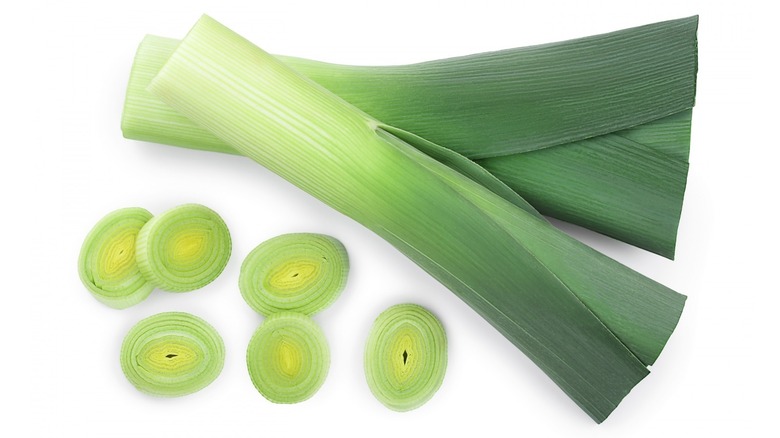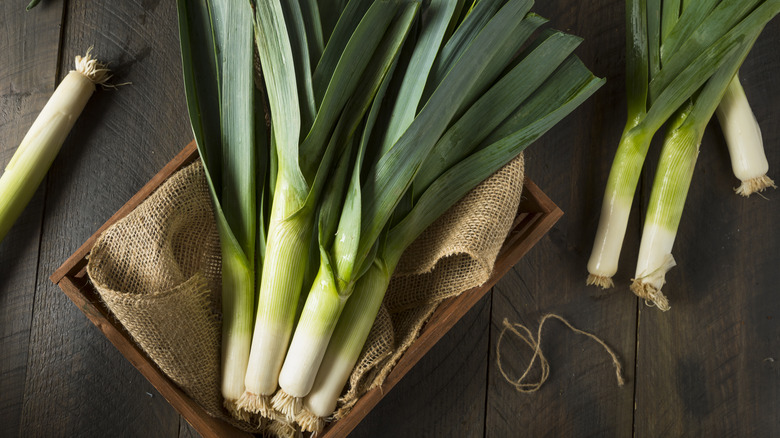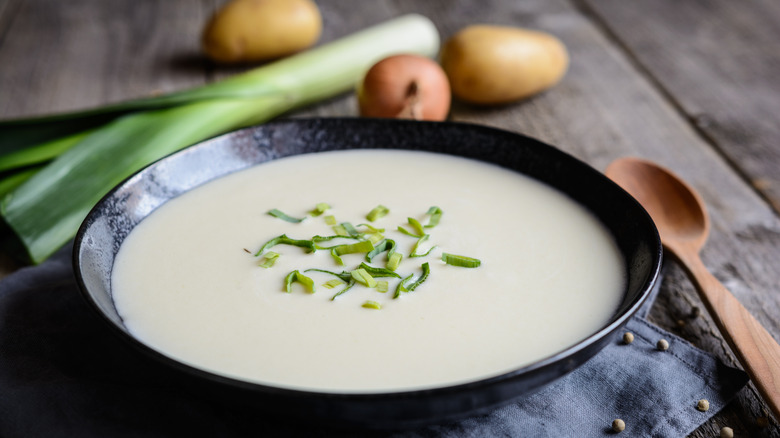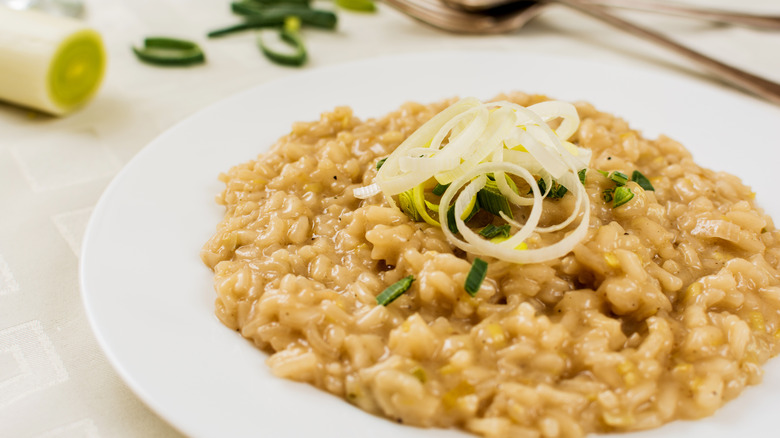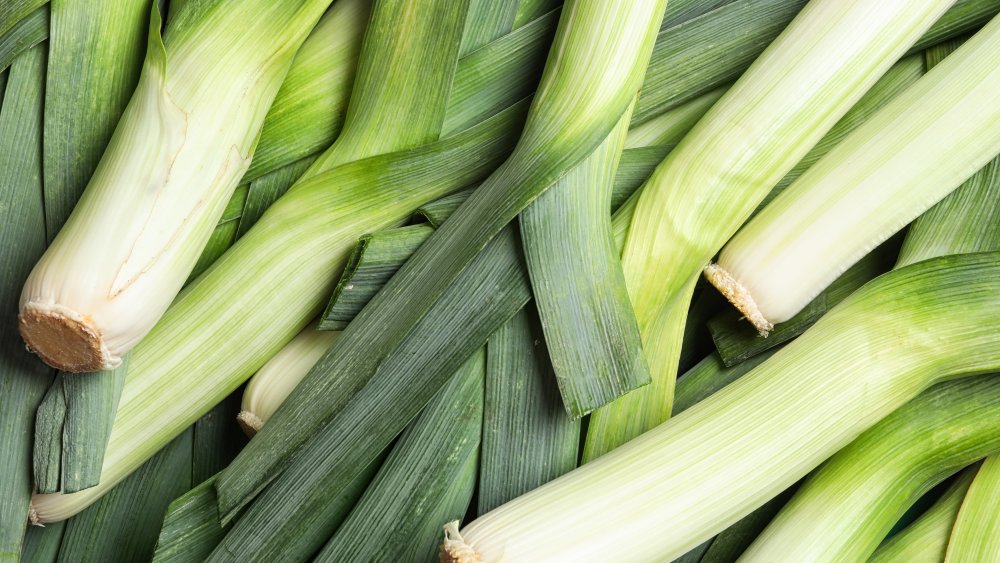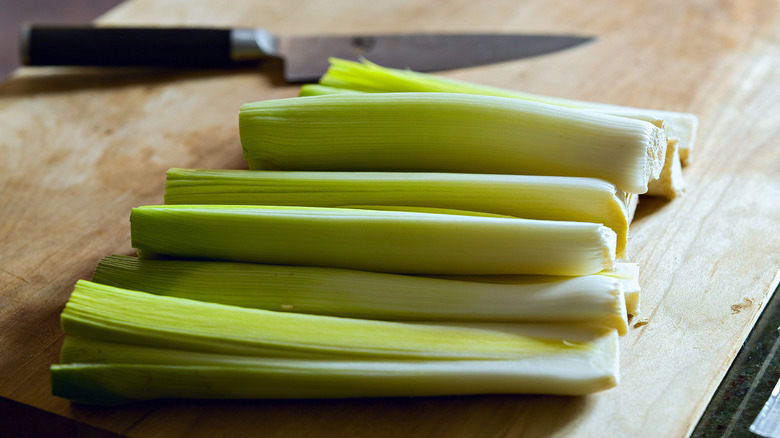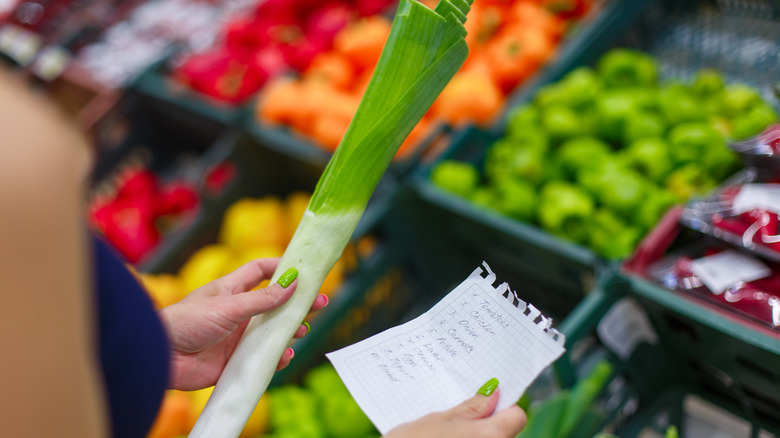What You Didn't Know About Leeks
With its lengthy history, the humble leek has established itself as something of an unsung hero. From its incredible nutritional value to its superhero status among the people of Wales, the leek has a reputation for showing up to the vegetable party and getting things done. According to Britannica, the leek is thought to be native to eastern parts of the Mediterranean and the Middle East.
Leeks are closely related to the onion and are a member of the allium genus along with garlic, scallions, and shallots. As MasterClass poetically puts it, the white and green vegetable consists of "tightly bound leaf sheaths that form stalk-like bases, which transition into flat leaves." Their flavor is said to be much milder than the onion (something the ancient Romans loved) and rather sweet. Love Food explains that the leek was said to be a favorite of the infamous Roman emperor Nero because he believed they would make his singing voice better, and the jury will forever be out on that one. Throughout European kitchens, leeks are still beloved today and are primarily used in soups, stews, and in dishes containing the hearty potato.
The heroic history of the leek
This stalky green veggie has a history that can be traced back to ancient Egyptian and Roman times, according to Kitchen Project. The Egyptians were known to cultivate the leek and use it as currency when bartering for services. Leeks are depicted in the burial tombs of ancient Egyptians, and records of the vegetable can also be found within the cookbook of famed third-century food writer Apicius, in which he credits Egypt for producing the best leeks. But the Egyptians and the Romans weren't the only ones that had a special place in their hearts for the leek; so did (and do) the Welsh.
Love Food reports that leeks saved the Welsh from the Saxons at the Battle of Heathfield in the year 633. Legend has it that a Celtic monk named David convinced the Welsh army to wear leeks on their helmets as a way to distinguish their brethren from the opposing Saxon army. Much to the pride of the Welsh, they won the battle, and David became known as St. David. To this day, he is honored with a holiday called St. David's Day, when Welsh people wear leeks on their clothing. The leek is also one of the national symbols of Wales, according to the country's government website.
What do leeks taste like?
As noted by MasterClass, leeks have some flavor notes in common with their garlic, scallion, chive, onion, and shallot relatives. While the vegetable certainly has onion-like natural sweetness, it is much milder and not nearly as assertive as its allium cousin. The properties of the leek also vary up and down the vegetable. Oftentimes, people discard the dark green tops, which are edible but much tougher than the lighter-colored parts of the plant.
From a taste perspective, though, both the light and dark parts of the leek have that characteristically sweet and delicate depth of flavor. They can be eaten raw in salads since they are not overly harsh, but most people may prefer them heated and softened. When cooked, they boast a "unique combination of silky textures and herbal-sweet flavors," says Fine Cooking. This gentle yet distinct taste makes leeks suitable as both a flavor enhancer and a main ingredient in a range of dishes.
How to cook with leeks
Leeks are often thought of simultaneously with potatoes, likely because of the widely beloved potato leek soup. The dish, called vichyssoise, was developed by a French chef in New York City as a chilled (but very creamy) soup for hot days, per Simply Recipes. However, the wildly versatile leek is capable of much more than playing second fiddle to the potato. Leeks can be enjoyed on their own when braised, sautéed with butter, or boiled and served with a vinaigrette. Taste promotes eating the whole leek, instructing cooks to begin softening the more fibrous green parts in a pan before adding the tender white bits. If you're not a fan of the green parts, though, Bon Appétit deems them an excellent inclusion in homemade stock.
To enjoy leeks in a heartier main dish, try them thinly sliced in Chinese-style vegetable pancakes, suggests MasterClass. If a starch craving hits, they're wonderful in pasta and risotto, as noted by Food Network. Next time you're about to use an onion in a soup, stew, casserole, or another savory dish, consider reaching for a leek instead for a different flavor.
Nutritional information about leeks
Love Food writes that leeks, "the original superfood," are a great source of fiber and other heart-healthy compounds like flavonoids and polyphenols, two nutrients that promote strong blood vessels. Leeks are a great source of beta carotene, which the body turns into vitamin A, and can aid with vision, immune function, reproductive health, and communication between cells, per Healthline. Leeks are also said to be high in vitamin K1, which boosts heart health.
Eating more leeks can be an especially great thing for anyone who has a menstrual cycle, as the vegetable possess significant amounts of manganese, which may soothe premenstrual symptoms and foster a healthy thyroid. And that's not all — Healthline reports that leeks boast vitamin B6, iron, and folate, as well as kaempferol, an antioxidant said to prevent heart disease and certain types of cancer. Finally, like its cousin garlic, leeks have allicin, which is known to have antimicrobial properties.
How to clean leeks
Before you cook with leeks and enjoy their nutritional benefits, however, it is important to clean them thoroughly, as MasterClass explains. Leeks tend to take in a lot of soil as they grow, and their tightly compact leaves seal the dirt in even after they're harvested. Before consuming the vegetable, clean the chopped pieces under the faucet or swirl them around in a bowl of cold water.
More efficiently, though, The Spruce Eats recommends cutting the root end off the leeks and then slicing them in half lengthwise, running water down each layer to rinse away any trapped dirt. Furthermore, be sure to dry your leeks well after cleaning them to ensure freshness (and better caramelization). Only complete this process when you're ready to use them, though, as Allrecipes notes that cut leeks may soak up the odors of other ingredients when kept in your fridge.
How to purchase leeks
When buying leeks, pick stalks that are firm, not mushy, and still have their roots attached, instructs Fine Cooking. Avoid any leeks that are limp or dull in color, says The Spruce Eats. While some stores may sell leeks pre-trimmed in plastic packaging, they're usually fresher and more likely to last longer when sold whole and unpackaged. Another thing to keep in mind is the size and ratio of white part to green part; if you're not planning to use the leek greens at home, consider picking out a baby leek that has mostly tender white parts.
Leeks can be found at all times of year at most grocery stores, but if you're shopping at the farmers market, you're more likely to see them when they're in season in the spring or from late winter to early summer (via Los Angeles Times). Or, leeks are super easy to grow in a home garden, so if you have the time and space, why not cultivate your own?
